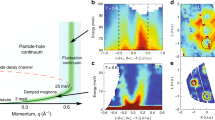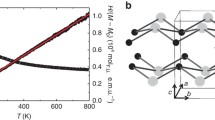Abstract
A phenomenological theory is explored for itinerant weak ferromagnetism. Free energy including the higher order terms of \(m^{4}\) and \(hm^{3}\) is introduced and examined. This free energy is derived from the mean-field free energy expression with the use of the Bragg–Williams entropy. We apply the present theory to the typical itinerant weak ferromagnetic materials \(\hbox {ZrZn}_{{2}}\), \(\hbox {MnSi}_{{2}}\), and others. To determine the model parameters, we use the experimental value of the magnetization under the large magnetic field or the extension of the Arrott plot with a functional form of hyperbola. This extended Arrott plot would explain various experimentally observed M–H curves at finite temperatures. Finally, we discuss the Sommerfeld coefficient in magnetic fields based on the present theory.


Similar content being viewed by others
Data availability statement
All data generated or analyzed during this study are included in this article.
Notes
Note in proof: Using the data of J. Takeuchi and Y. Masuda, we find the magnetic susceptibility \(\chi _{\sim 0}^{\textrm{exp}}\) for Sc\(_{3}\) In is 0.56, not 1.12 listed in the table. [18] This value results in the metamagnetic-like behavior not observed in Sc\(_{3}\) In.
References
E.C. Stoner, Proc. Roy. Soc. London 165, 372 (1938)
T. Moriya, Spin Fluctuations in Itinerant Electron Magnetism (Splinger-Verlag, Berlin, 1985)
B.T. Matthias, M. Bozorth, Phys. Rev. 109, 604 (1958)
S. Ogawa, N. Sakamoto, J. Phys. Soc. Jpn. 22, 1214 (1967)
S. Foner, E.J.M. Jr., V. Sadagopa, Phys. Rev. Lett. 19, 1233 (1967)
A.P.J. van Deursen, L.W.M. Schreurs, C.B. Admiraal, F.R. de Boer, A.R. de Vroomen, J. Mag. Mag. Matt. 54, 1113 (1986)
E.A. Yelland, S.J.C. Yates, O. Taylor, A. Griffiths, S.M. Hayden, A. Carrington, Phys. Rev. B72, 184,436 (2005)
B. Bloch, J. Voiron, V. Jaccarino, J.H. Wernick, Phys. Lett. 51A, 259 (1975)
W.E. Gardner, T.F. Smith, B.W. Howlett, C.W. Chu, A. Sweedler, Phys. Rev. 166, 577 (1968)
K. Kamishima, R. Note, T. Imakubo, K. Watanabe, H.A. Katori, A. Fujimori, M. Sakai, K.V. Kanenev, J. Alloys Compd. 589, 37 (2014)
F.R. de Boer, C.J. Schinkel, J. Biesterbos, S. Proost, J. Appl. Phys. 40, 1049 (1969)
L.D. Landau, E.M. Lifschitz, Statistical Physics, 2nd edn. (Pergamon Press Ltd., London, 1969)
J.C. Tolédano, P. Tolédano, The Landau Theory of Phase Transitions (World Scientific, Singapore, 1987)
I. Dzyaloshinsky, J. Phys. Chem. Solids 4, 241 (1958)
E.P. Wohlfarth, P.R. Rhodes, Phil. Mag. 7, 1817 (1962)
N.H. Duc, D. Givord, C. Lacroix, C. Pinettes, Euro. Phys. Lett. 20, 47 (1992)
A. Arrott, Phys. Rev. 108, 1394 (1957)
J.Takeuchi, Y.Masuda, J.Phys.Soc.Jpn. 46, 468 (1979)
K. Matsumoto, S. Murayama, Solid State Phenomena 289, 179 (2019)
K. Matsumoto, S. Murayama, J. Phys. Soc. Jpn. 91, 094,603 (2022)
E.P. Wohlfarth, J. Appl. Phys. 39, 1061 (1968)
Funding
No funds, grants, or other support was received.
Author information
Authors and Affiliations
Corresponding author
Rights and permissions
Springer Nature or its licensor (e.g. a society or other partner) holds exclusive rights to this article under a publishing agreement with the author(s) or other rightsholder(s); author self-archiving of the accepted manuscript version of this article is solely governed by the terms of such publishing agreement and applicable law.
About this article
Cite this article
Matsumoto, K. A phenomenological theory of itinerant weak ferromagnetism. Eur. Phys. J. B 96, 7 (2023). https://doi.org/10.1140/epjb/s10051-022-00459-x
Received:
Accepted:
Published:
DOI: https://doi.org/10.1140/epjb/s10051-022-00459-x




